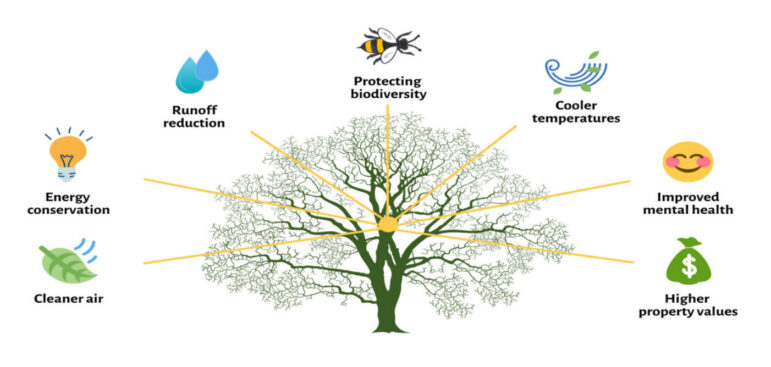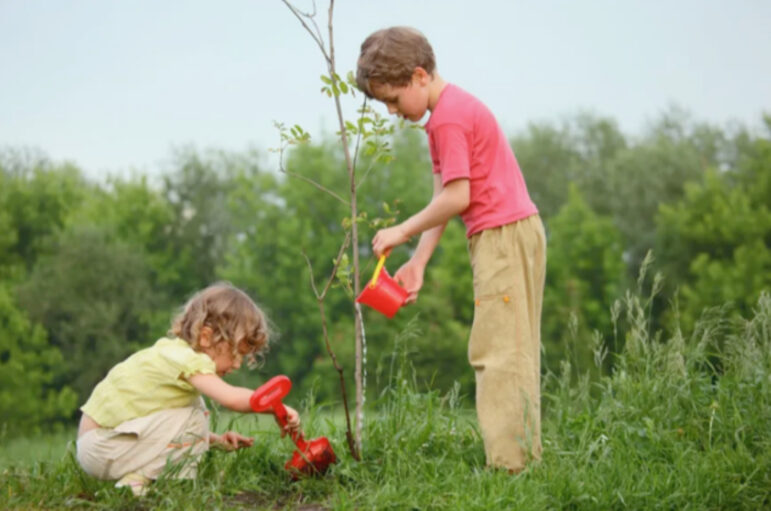Written by Joan Tracey Seguin
Third in Greenwich Sustainability Committee’s One Land Series on Biodiversity

We grow up learning about the countless benefits of trees. They give us oxygen, sequester climate-damaging carbon and filter out harmful pollutants in our drinking water and the air we breathe. The value is immeasurable and on such a large scale that we sometimes forget how that mighty oak or the maple with the beautiful fall foliage in our yard is directly contributing to our everyday lives. However, the trees on our property do have immediate and very measurable benefits that add value to our homes, improve our health and the health of the planet. It is time to take stock of the Green Gold in your yard and put down some MORE roots.
Greenwich residents have been seeing unprecedented rainfall, leaving homes flooded and much worse for some. Trees can help lessen the impacts of excess rain on our properties and our neighborhood by storing rainfall on their leaves, branches and bark before it even reaches the ground. Mature trees can intercept up to 35% of the rainwater that falls on them, holding it in their canopy where it evaporates or slowly drips to the ground reducing soil erosion and standing water during strong storms. On the ground, rain is absorbed by the tree by their roots and their leaf litter creates pathways and soil conditions that help rain to infiltrate the soil. One tree alone can reduce stormwater runoff by over 4,000 gallons per year, preventing it from flooding our basements and overwhelming our storm drains and wastewater facilities.
Trees are also natural acoustic barriers, helping to dampen noises that impair our quality of life. Whether it’s noise from nearby home improvements, a busy street, or noisy landscapers, it’s difficult not to notice the constant barrage of noise, especially with more folks working from home. A healthy grove of trees or at least a few well-placed trees directly reduce sound intensity through natural sound attenuation. Better yet, trees have the added benefit of attracting wildlife. Birds singing, katydids chirping and wind rustling the leaves, all help to mask unpleasant noise.
As homeowners, we go to great lengths to conserve energy for cost savings and environmental awareness. Deciduous trees save energy in summer by shading houses, but allow the sun to filter through in the cold months and evergreens protect against cold winds. All trees, but especially those strategically placed, can provide shading on hot, humid days, cool the air around our homes and cut energy costs. Tree cover alone can lower summer temperatures by 2–9°F.
Trees make us feel better. Study after study show that exposure to trees boosts our immune systems, lowers blood pressure, increases our ability to focus, and shortens recovery times following illness. Our health is also dependent on the health and complexity of biodiversity.
Trees improve biodiversity by providing habitat to over 80% of terrestrial wildlife. A mature oak tree can support over 500 types of pollinators through the seasons, which means that our bird populations, the bellwether for environmental health, can be sustained.

Like most suburbs the landscape in Greenwich has been fragmented into parcels that favor lawns over trees, minimizing habitat that is critical to biodiversity and to our health. Take stock of the few large mature trees in some neighborhoods and notice that they often stand solitary in the landscape. Just like people, trees do better when they are mutually supported in groups. As we are now learning, trees support each other by communicating through their root systems, delivering nutrients and needed support when neighboring juvenile trees are under stress. Roots also provide interlocking structural support in strong weather. Returning native trees to our properties provides connectedness for all wildlife.
Trees need our help, from saving the ones we have to planting new ones. We are losing trees faster than we are replacing them to old age, invasive insects and disease as well as home expansions and development in our neighborhoods and backyards.
We need to take care of the trees we have. Let’s think twice prior to taking down large healthy mature trees. With a little foresight and planning, the all-or-nothing approach is not always necessary. Healthy, mature trees have survived the storms of the past hundreds of years and can continue throughout their lifetime with minimal care and maintenance. Tree checkups by a knowledgeable arborist can assess the health of our trees, identify hazardous limbs that pose a safety risk and lighten the canopy at just a small fraction of the cost in comparison to the many savings and health benefits. Unnecessarily taking down trees can also lead to unforeseen consequences such as flooded backyards and sweltering heat and once gone, a newly planted tree would need many years to replace the lost health benefits and many more to achieve the majesty of a full-grown tree.
Tree removal is unavoidable at times. But remember to be friendly to wildlife and limit tree work until late fall and winter when birds and other wildlife are no longer nesting. Replant trees!
Trees are not being replaced as often as they once were. Our developed properties and manicured lawns inhibit seedlings from getting a foothold, and those that do, fall victim to our weed whackers and mowers. Seek the advice of a landscaper or arborist to find the “right tree for the right place” to maximize the benefits to you and the tree. Make sure to choose native trees. Not only have they naturally evolved to our soil and climate conditions enabling them to thrive with little effort on our part, they also have formed symbiotic relationships with native wildlife over thousands of generations resulting in the most sustainable natural ecosystem. If possible, plant a variety of native trees or a mixed border. A variety of native trees improves wildlife diversity and having a diverse landscape is more resistant to disease and extreme weather. Just imagine what our manicured landscape would look like if a disease impacted our arborvitae as it decimated the American chestnut or American elm. Mixing in native junipers, holly, rhododendron, and spruces will assure privacy and resilience.

Many residents are horrified to find that new neighbors or developers can come in and clear-cut beloved trees that have provided a beautiful view or shade, perhaps a buffer along a stream or a privacy screen. Sellers may elect to create a partial easement to protect trees on the property they transfer, preventing new owners from removing them. We are drawn to neighborhoods with
stately trees and tree-lined streets where large canopies turn inhospitable environments into
pleasant places for people to walk and bike. We need to do our part to keep our properties part
of the tree puzzle that beautifies our neighborhood and creates a desirable place for everyone
to live.

So plant a tree today with your (grand) kid, snap a photo and watch them both grow while sharing their
values with your neighbors, community, country and planet.
“The best time to plant a tree was 20 years ago. The second best time is now.”